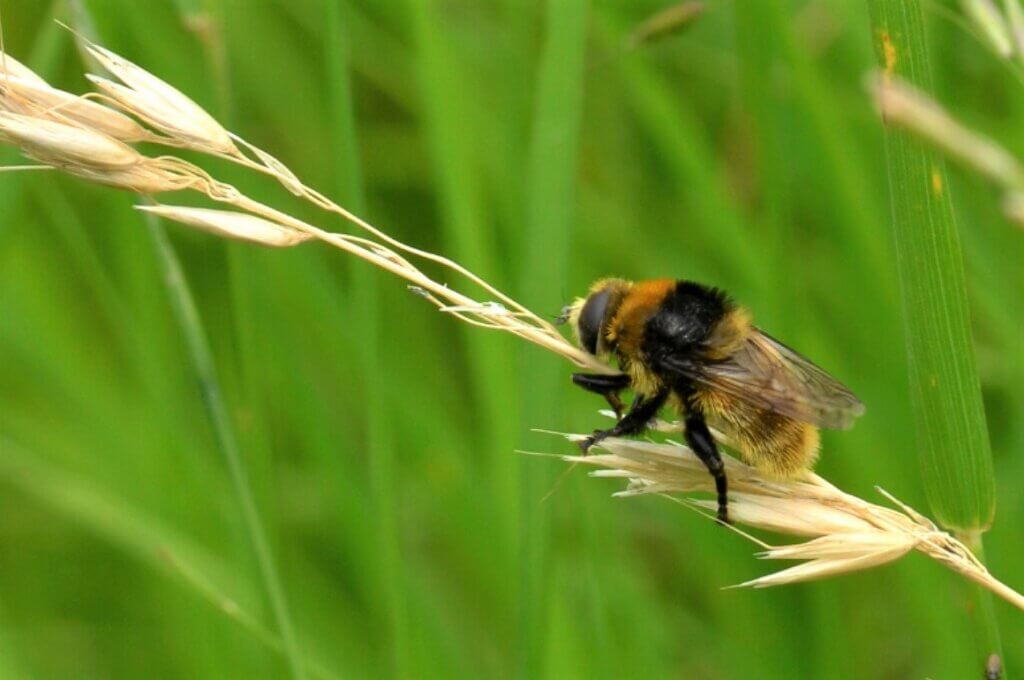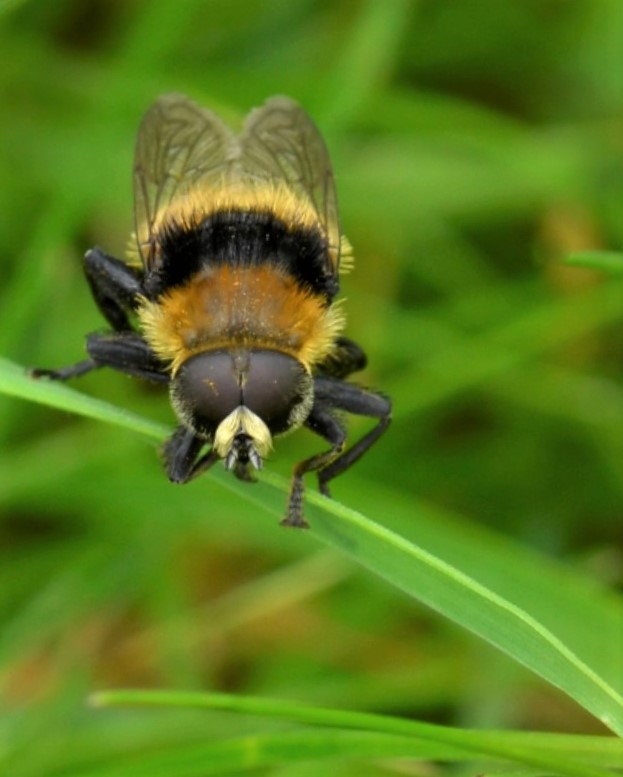
Nick Ballard’s interest in butterflies and moths evolved exploring the hedgerows and fields, streams, ditches and ponds, meadows and verges that formed the great outdoors where he lived as a child – Selby, on the river Ouse in Yorkshire. He first worked as a computer operator in Cambridge in the Computer Aided Design centre and then for many years as a consultant. He is a member of many national and local conservation organisations including Butterfly Conservation.
Daffodils. Yes, we all love daffodils, harbingers of the end of winter and colour of the spring light as bees and butterflies sip nectar from their yellow cups. The chocolate box image of native daffodils sweeping across a golden meadow, next the stream by the green wood, with crystal clear water and pigment blue skies. We see them, peeking out from the hedge, in regimented lines along the roads unexpectedly broken by an artful display of clumps, around the park and green or surrounding the posts of the old village sign. But it’s all so neat and tidy, with mown grass and manicured hedges, nice cultivated borders and flower beds, a place where everything has its place. I begin to see daffodils not as spring light, but as yellow-vested vigilantes with an eye for trouble, demarcating the space. “Nature has to know it’s place; we allow it in where it doesn’t make a mess, and we can keep it neat and tidy. Wildlife will fit-in as it always has done. We’ve put up some bird-boxes.”
Sadly, “fitting in” hasn’t worked out well for our wildlife in the last 50 years. The RSPB, along with other conservation and wildlife charities, published the State of Nature Report 2019: “Our statistics demonstrate that the abundance and distribution of the UK’s species has, on average, declined since 1970 and many metrics suggest this decline has continued in the most recent decade. There has been no let-up in the net loss of nature in the UK“. That loss occurs through lack of investment in proper management of our wild places, massive infrastructure projects, such as motorways and HS2, and in small places, like village greens, verges, parks and old cemeteries, even our own gardens. As habitat disappears, so does the wildlife; it is a simple equation really. Clearly, current thinking and practice has done nothing to stop this decline. Surely it is time for different thinking? We are part of nature, not apart from it.
Daffodils’ popularity has resulted in many groups of volunteers gathering for “Bulb planting Days”, where everyone who wants to do something positive for the local environment goes out and plants bulbs of, well, daffodils. It’s an easy choice – everyone loves daffodils. Now, I have nothing against daffodils – far from it, I’d rather have them than not – but from an environmental point of view, there are far better native plants, with greater variety, that would do more for insects, birds and mammals, than the daffodil. Let’s face it – what does it do for the other 11 months of the year when it isn’t flowering? It develops a seed-head, which not much seems to eat, then the leaves flop down into the grass or undergrowth, where it rots and provides food for slugs, snails, fungi and worms in autumn and winter, and that’s it. That’s eleven months for one flower. We can do better than that.
Interestingly, one unexpected consequence is the increased abundance of Narcissus bulb flies in UK gardens – Merodon equestris, Eumerus strigatus and Eumerus funeralis. So much so, that it is a problem worthy of attention by the RHS, no less. Victorian gardeners imported the large narcissus bulb fly (Merodon equestris), not intentionally of course. The fly arrived as larvae within consignments of bulbs, in the late 1800’s; it is now widespread. Like many plants that were accidental releases and are now almost seen as part of our native flora, so too has the large narcissus bulb fly thrived. Unfortunately, as this has larvae that can attack and destroy healthy bulbs, those gardeners picked the worst bulb-fly to unknowingly introduce.

So I see daffodils differently now; when I see the hard work undertaken to plant them and mow the grass, trim the hedge and weed the borders, I sometimes sigh, knowing that all that effort has resulted in a few short weeks of colour, with so little return for nature. I muse about what plants I would grow to easily replace many of those daffodils, amongst the neatly trimmed privet hedges and “municipal” grass lawns. – native blue-bells, wood anemone and avens, fox-gloves, campions and cowslips, forget-me-not, primroses, honesty, garlic mustard, lady’s smock, nasturtium, buckthorn, blackthorn, vetches and daises, knapweed, native grasses, to name a few. I see swathes of wildflower meadow across the village green, hedgerows and bushes in flower, hedgerow plants, birds and animals thriving in the wild undergrowth – and all for less energy expended than planting the bulbs, tidying the beds, trimming the hedges and cutting the grass. It is often that way when approaching conservation in an urban or built-up environment – less is often more. The clue is in the name – wild things need wild places to thrive.

And then I smile. Merodon equestris and friends are watching and waiting before busily laying eggs and their larvae are happily munching away on the very bulbs that are being planted, whilst the gardeners that plant them congratulate themselves on making things look “neat and tidy”; then their daffodils wilt and die. Unintentionally, the law of unexpected consequences has kicked-in; some good has come of it…
Not that I don’t love daffodils…….
[registration_form]
In the Chilterns were we are there remains a very few pockets of truly wild daffodils. They are reasonably distinct from the gardeners daffodils being smaller, paler and more regular in size. When one looks around the gardeners daffodils are never very far away from the wild ones in nice neat tidy clumps. They pose a real threat to the wild ones because of hybridisation.
As is said nature needs wild places to thrive NOT neat and tidy fields and gardens where hedges are flailed almost to stumps to render them utterly useless for wild life. We have this terrible paranoia to make everything tidy. Ivy, one of the most valuable plants for wildlife is cut off trees for example, No wonder nature is reeling from our meddlesome fingers. When will we ever learn? May be never.
…..and don’t get me started on IVY!
The majority of our society still haven’t learned to let nature do it’s own thing as much as possible. This obsession with ‘neatness’ will be the death of nature, even if other stuff doesn’t do it.
Article in British Wildlife about a couple (entomologists) who bought a small field and stopped the summer grazing. Sure enough, one of their country neighbours accused them of letting it go ‘to rack and ruin’, which is what they’ve called it ever since. Careful management (winter grazing) has let wildlife really rebound of course. Cut it, strim it, spray it to death, plant non-natives all over it….
I love Daffodils but where they belong garden varieties IN THE GARDEN, we have many in our garden ourselves. Wild ones, well they could be planted in the garden, beautiful as they are as long as they are not stolen from the wild but they are the only Daffodils that belong in the wild on our verges or in fields. I can remember working in Herefordshire some years ago and seeing some truly wild Daffs in fields, hedge banks and the edges of woods, really great to see.
Garden Daffodils planted on verges and out in the wild just remind me of the stupidity of my fellow man and his lack of appreciation of our own native wild flowers and his casual unthinking trashing of that native biodiversity.
This is why I can’t stand the sight of any ornamental plant in a non garden, natural site. To me it says whoever planted it found the native fauna and flora inadequate they had to ‘gardenise’ what should have been a wild spot. In the wood that I worked in it was noticeable that there were frequent complaints there was not enough colour in the summer, the wood couldn’t be appreciated for what it was it had to look like a garden. I noticed a catalogue for a company that sold native plants actually raised this issue saying that people should accept that at certain times of year there aren’t many flowers in woods. I know that a few miles away from me in Cumbernauld a major town wide natural landscape initiative is plagued with people wanting to stick ornamental plants in the wild spots. This is a huge issue and even way out in the countryside this mentality holds sway as Mark Cocker and George Monbiot have pointed out. Another point the conservation movement has to knuckle down and challenge rather than wring its hands because it worries about offending any members of our darling public.
Ages ago we reviewed the grass mowing regime at Westonbirt Arboretum, realised that the neat municipal grass was costing a fortune and achieving very little, stopped mowing other than paths and some glades and accidentally created a new spring highlight – blubells and dandelions – as bright and beautiful as planted daffodils, with the bonusof bright yellow shading to deep blue on the woodland edge.
I’ve seen glorious displays of dandelion being mowed/sprayed while elsewhere people plant daffodils – no rhyme or reason to it. Westonbirt is glorious I visited it frequently when I lived in Gloucester (1977 – 1983) so thank you Roderick for your part in making it what it was, much appreciated!
Food for slugs, snails, fungi and worms sustains slugs, snails, fungi and worms that become food for insects, birds and mammals.
I look forward to seeing native honesty and nasturshalum
I agree; honesty, I can’t abide hypocracy, even in government….
When I see habitat being destroyed by ‘nature lovers’ I truly weep like anyone else. ‘More birds boxes!’, that’s what I say!
I’m afraid they do hybridize.
Alan is 100% right about ivy, we all see it as a creeping weed, it’s not, he’s also spot on about the hedges too, and it’s not just farmers either who should take the blame, but those who in theory should know a lot better.
I agree with him, I don’t think we’ll learn, you learn by the experience of doing stuff not theories learnt in central heated offices with endless focus groups, (yes Forestry Commission it’s you prats).
On ivy I didn’t realize the cows go mad for it, and we are now closing in on what Knepp did by enclosing the entire farm with compartment fencing, no grant available any more for this, so somewhat of an eye-watering experience.
But now the cows can browse through selected woods and that’s important, it’ll create an open shrubby texture to the ground, and it’s could create a reintroduction I didn’t think possible – The Duke of Burgundy.
Pooing, seed transplant and bashing about will be just what the doctor ordered, might just be the incentive to attract the emperors down more to ground level to have their picture taken.
Re the war on ivy – at three woods in my district, one of which is a nature reserve, I’ve seen signs of ivy being pulled off trees almost certainly by totally different people. A group of volunteers for a museum in Stirling proudly posted that they’d ripped down the ivy from the walls in the car park – no explanation why just a given this is a good thing. I saw a local company that has won environmental awards tearing out ivy and when I emailed them about this never got a reply. In the wood we were doing conservation work in an older man (who’d disrupted a tree planting day with kids so he could stick in daffodils and encouraged a chainsaw wielding fourteen year old to help remove ‘ugly’ deadwood) wanted volunteers to rip off ivy from the surrounding walls, masses of it that had been growing for decades. Not only would it have been disastrous for wildlife in about 70% of cases ivy actually helps walls by protecting them from air pollution and frost damage. https://www.geog.ox.ac.uk/research/landscape/rubble/ivy/ivy-report.pdf
Ivy is crying out for some public championing. The conservation orgs could be proactive in challenging the misinformation and vilification for a start. It would be good to see a point made of ivy and other woodland plants being put in too whenever there’s a new planting of trees. I think there’s also an option for urban areas to be surveyed and when suitable walls are located a plan to add ivy for wildlife, to protect the walls, to help remove pollutants from the air and for the foliage to slow down rainfall reaching the ground to reduce flash flooding. Messages could be stencilled on the walls such as – THE IVY ON THIS WALL WILL PROTECT IT FROM FROST DAMAGE AND BE GOOD FOR WILDLIFE or AS THIS IVY GROWS IT WILL CLEAN OUR AIR AND HELP OUR POLLINATORS, PLEASE RESPECT IT. Eventually the messages will be obscured, but hopefully by then people will be better informed. Towns and cities green with ivy clad walls would be such better places. Worth a try?
In a local overgrown cemetery (which was fantastic for woodland wildlife) the Civic Society have been ‘restoring’ the place. Over 500 monuments, as well as many trees – ‘ivy kills trees’ – been stripped of ivy. They have effectively removed the whole ‘understory’ where animals and birds forage for food, yet refuse to accept they are harming the wildlife – ‘we love wildlife; look, we put up some bird boxes’. Plus ca change….
Yes it’s bloody terrible – my mum’s next door neighbour tore off the ivy from all the trees in her garden on the basis they strangle trees too! It needs high profile assertive and authoritive action from the conservation movement to counter the guff in some parts of the press and the ‘wisdom’ that’s being passed around re ivy. The public are too easily manipulated by misinformation, and that’s easier when there’s a void left by lack of effective public education, or in this case effectively none. It’s absolute bloody mental torture to see this ecological vandalism being carried out and trying to challenge it on an individual basis is hard graft and not very productive. I would love to see someone like David Attenborough do a wee feature on this possibly starting on how much damage has been done to wildlife already by this ignorance about ivy. Birds nest and bats can roost in it, it’s a phenomenal late season nectar source and it can even help insulate your house. A real wonder plant and it’s being despised.
Someone has planted daffs in the verge where a piece of SSSI ancient woodland borders both sides of the road. When the flowers are over, and nobody is looking there is a strong chance they might disappear. What is the name for the opposite of guerrilla planting?
Pirate pulling?
A good try Les, but unfortunately the conservation orgs are the worse contenders. Volunteers see ivy as a weed, so they scrub it out.
These past 7 years have been an eye opener for me, especially when you ask what experience these people have in land management and species recognition, we won’t accept any advice from people who’s previous job was working for a Building Society, but they love working in nature.
Yes they were terrible offenders for taking all the brash from a conservation task and then burning it so everyone could have a jolly good fire too. The lost opportunity for creating a habitat pile which can provide a home for invertebrates, hedgehogs, amphibians and nesting birds for years and years is sickening. I’ve seen piles being inspected by robins, wrens, dunnocks and even song thrushes within minutes of being created. So many practical conservation projects were either silly to start of with or very badly done, I’ve seen an awful lot of time, effort and money being wasted. That’s why I love clearing invasives always a good thing to do and very difficult for anyone to screw up.
Thanks for your many comments; I can see a few possible Guest Blogs developing already. I too have experienced the ‘wildlife-friendly’ volunteers in civic organisations happily strip ivy from the trees and cut the stems through at the bottom to ‘stop the ivy killing the tree’. Though that may have to wait….
Nick